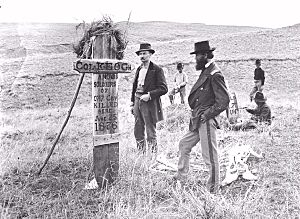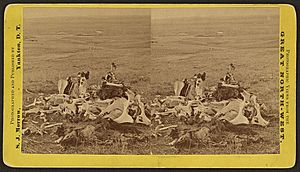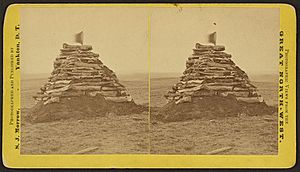George K. Sanderson facts for kids
Quick facts for kids
George Kaiser Sanderson
|
|
|---|---|

1879 photograph of CPT George K. Sanderson examining the maker erected where COL Myles Keogh and most of his company died during Battle of the Little Bighorn
|
|
| Born | September 9, 1844 Lebanon County, Pennsylvania |
| Died | February 2, 1893 (aged 48) Lampasas, Texas |
| Allegiance | Union |
| Service/ |
Union Army |
| Years of service | 1861-1891 |
| Rank | |
| Unit | 15th U.S. Infantry
33rd U.S. Infantry 11th U.S. Infantry 18th U.S. Infantry |
| Commands held | Fort Custer (Montana) Fort Ontario |
| Battles/wars | American Civil War |
| Awards | Breveted 1st Lt. and Capt. for gallant and meritorious service. |
| Relations | John P. Sanderson |
George Kaiser Sanderson (born September 9, 1844 – died February 2, 1893) was an officer in the United States Army. He started his military career as a private soldier. Later, he became an officer. He was honored twice for his brave service during the American Civil War.
Sanderson also built the very first monument at the site of the Battle of the Little Bighorn. Today, this place is known as the Little Bighorn Battlefield National Monument.
Contents
Early Life and Family Connections
George Kaiser Sanderson was born in Lebanon County, Pennsylvania. His father, John P. Sanderson, was a newspaper editor. He was also a politician who was elected to office. George spent most of his childhood growing up in Philadelphia. His father continued to work in newspapers there. He also worked as a lawyer. George first married a woman named Mattie. Later, on June 6, 1888, he married Emeline Buford in Illinois.
Serving in the Civil War
Sanderson joined the army as a private soldier on October 24, 1861. He was part of the 15th U.S. Infantry. His father, John P. Sanderson, was already a lieutenant colonel in the same regiment. George became a second lieutenant on October 31, 1861.
He was recognized for his bravery at the Battle of Shiloh in Tennessee. For this, he was given the honorary rank of first lieutenant on April 7, 1862. This kind of honorary rank is called a "brevet." He was promoted to a full first lieutenant on November 9, 1862. Sanderson received another brevet, this time as a captain, on September 1, 1864. This was for his brave service during the Atlanta Campaign.
Sanderson also worked as a staff officer. He helped manage supplies for his regiment. This role was called Regiment Quartermaster. He held this job from April 6, 1865, until March 28, 1866. At that time, he was promoted to Captain. He later served again as a staff officer. He was an assistant commissary of musters. He also acted as an aide-de-camp from November 11 to December 30, 1867.
Joining the 33rd Infantry
The 33rd Infantry was formed on May 4, 1861. It was first known as the Third Battalion, Fifteenth Infantry. On September 21, 1866, it was renamed the 33rd U.S. Infantry. This change happened because of a new law. On May 3, 1869, this regiment joined with the Eighth Regiment of Infantry.
Captain Sanderson was moved to the 33rd U.S. Infantry on September 21, 1866. He worked as an Acting Assistant Adjutant-General. This means he helped manage the daily operations for Major General Pope. General Pope was in charge of the Third Military District in Atlanta, Georgia. On May 3, 1869, Captain Sanderson was listed as unassigned.
Service in the Indian Wars
On December 18, 1869, Sanderson was assigned to the 11th U.S. Infantry. He was then stationed in the Department of Texas.
Working in the Department of Texas
On July 26, 1874, an official named Edward P. Smith gave orders. He told Colonel Davidson to register non-hostile Native Americans. This was to happen at the Comanche-Kiowa agency by August 3, 1874. Colonel Davidson gave this job to Captain G. K. Sanderson. This meant that the Indian Agent, James H. Haworth, had less control over the registration.
Captain Sanderson first went to a Comanche village. It was ten miles north of Fort Sill, in the Indian Territory. There, he registered the groups led by Horseback, Quirts Quip, and Cheevers. The next day, he visited the Kiowa camp. However, Kicking Bird could not gather enough of his men to register. Captain Sanderson told Kicking Bird to bring his men to the agency the next day. The Kiowas came on August 3. But a man named Ma-ye-tin, or Woman's Heart, caused problems. Captain Sanderson wanted him arrested, but Agent Haworth disagreed. On August 8, the Yamparika people were registered. Captain Sanderson oversaw this process.
Moving to the Department of Dakota
The first extra soldiers for the Great Sioux War of 1876-77 arrived on August 26, 1876. These were two companies led by Captain Sanderson. He then took command of the Post at Cheyenne River Agency. This place was in Dakota Territory and was later called Fort Bennett.
On September 13, 1879, Captain George K. Sanderson was tried by a military court. This happened at Fort Keogh, Montana. He was found not guilty. However, the higher command did not agree with this decision.
Building the First Custer Battlefield Memorial
Captain George K. Sanderson and the 11th Infantry built the very first memorial. This memorial was placed at the site of the Little Bighorn Battlefield National Monument.
On October 29, 1878, Major George D. Ruggles sent a letter. He told Lieutenant Colonel George P. Buell to send a group to the Little Bighorn River. Their job was to collect all human bones. They were to place them inside a cone or pyramid of stones. Major Ruggles wrote that the best place for the grave was the highest point of the ridge. This was right behind where General George Custer's body was found.
Captain Sanderson sent a report from Fort Custer, Montana, on April 7, 1879: "Sir: I need to report about my trip to Custer Battlefield. I followed the orders about the graves there. It was impossible to find rocks within five miles. So, I built a mound using cord wood instead. In the middle of the mound, I dug a grave. I buried all the human bones that could be found there. This grave was then built up with wood. It stood four feet above the ground and was well covered. The mound was built over and around it. The mound is ten feet square and about eleven feet high. It is built on the highest point right behind where General Custer's body was found.
Instead of moving any remains, I carefully rebuilt all the graves I could find. At each grave, a stake was placed. This was done where earlier stakes had fallen. After carefully searching the whole area, the remains now buried under the mound were all that could be found.
The land to the north and east of the field was searched for six miles. No other remains were found. There was nothing to show that anyone else was killed in that direction. The whole field now looks very clean. Each grave has been rebuilt. All animal bones have been removed. This work should be finished as soon as possible.
Your Obedient (Signed)
G.K. Sanderson
Capt. 11 U.S. Infantry."
A photographer named Stanley J. Morrow took pictures of Captain Sanderson's work. These photos show horse bones gathered on Custer Hill. They were in large piles before being buried in the wooden monument.
A beautiful hill called "Gracie's Butte" stands out in the valley. It is named after Miss Gracie Sanderson. She was the daughter of Captain Sanderson. This hill is a clear landmark in the area.
Captain G. K. Sanderson was the commander of Fort Custer (Montana). He served there from August 1879 to October 1880.
In 1883, he was assigned to recruit new soldiers. This was at Davids Island (New York) in New York Harbor. Captain George K. Sanderson was granted a one-month leave of absence on April 11, 1883. On May 7, 1884, his leave was extended for six months. This was due to a medical certificate.
Serving in the Division of the Atlantic
On July 29, 1887, Company C, Eleventh Infantry, left Fort Yates, North Dakota. They moved to and were stationed at Fort Ontario, New York. From 1887 to 1891, Captain George K. Sanderson commanded Fort Ontario. He also commanded Company C, with headquarters from Madison Barracks.
On March 19, 1891, First Lieutenant Henry O. S. Heistand became a captain of infantry. This was because Captain Sanderson was promoted. He was then assigned to the 18th Infantry.
Joining the 18th Infantry
Captain George K. Sanderson of the 11th Infantry became a major of infantry on March 19, 1891. He was stationed at Fort Clark, Texas. This fort was near Brackettville, Texas.
Major George K. Sanderson of the 18th Infantry retired from the army on April 2, 1892. He passed away on February 2, 1893, in Lampasas, Texas.




